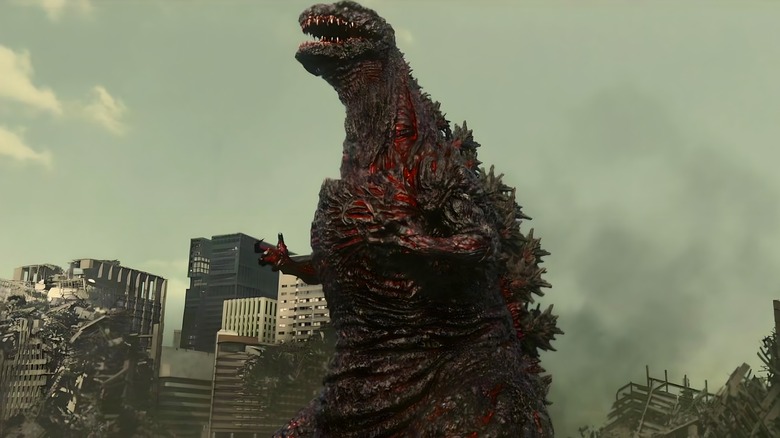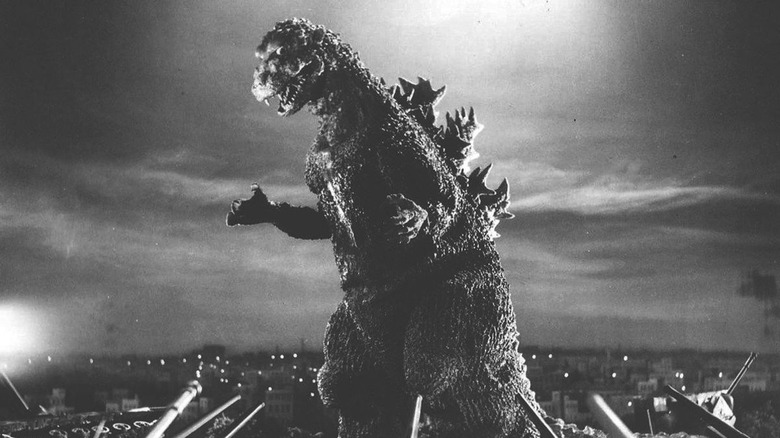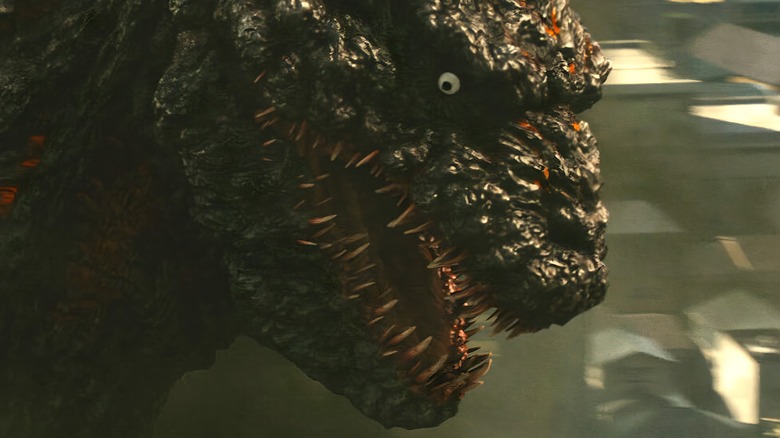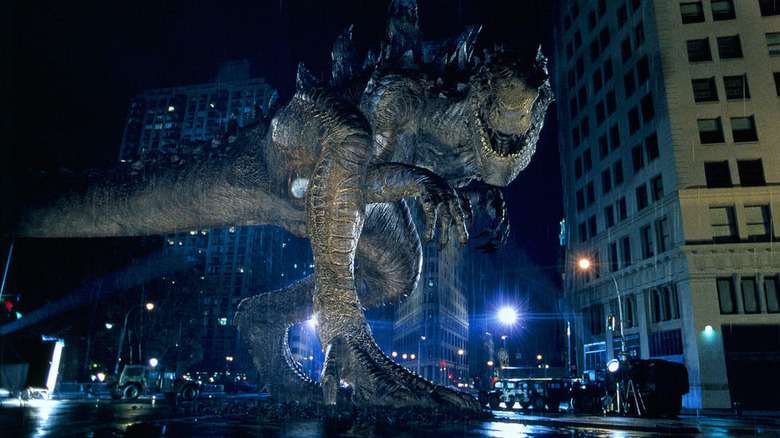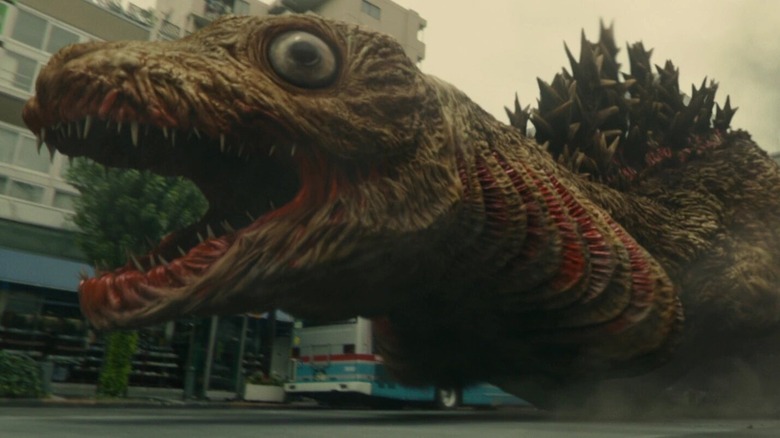Make Godzilla Scary Again (And Hire Clive Barker For The Job)
Giant monster movies are some of the most entertaining blockbusters out there, but they're often dismissed as mindless, escapist entertainment. Sure, many of them are designed to provide entertaining crowd-pleasing thrills, but that doesn't mean they can't be more than that. The "Godzilla" franchise, for one, truly soars when it embraces existential horror over monster carnage, and that's the direction the saga needs to take moving forward.
"Godzilla" has been around for almost 70 years, and the series has undergone many transformations during that time. Toho Studios has always adopted a loose approach when it comes to the King of the Monster's cinematic outings, which has led to some unique movies. That said, it's a franchise that, in the grand scheme of things, tends to prioritize fun over soul-crushing despair — which is a shame, as the original remains a powerful horror film to this day. Hollywood, meanwhile, has always shied away from Godzilla's inherent potential for darkness. From Roland Emmerich's 1998 blockbuster to Legendary Pictures' MonsterVerse, American "Godzilla" movies are all about providing escapist entertainment.
There's nothing wrong with that, but this mindset is why great visionaries such as Clive Barker never got to bring their ideas for "Godzilla" to life — which, yes, is something that almost happened. Now, with Toho's "Godzilla" set to return later this year, the franchise has an opportunity to return to its roots as a dark, contemplative cautionary tale. With that in mind, let's explore the dark side of Japan's favorite monster and discuss why it's the best version.
The dark origins of Godzilla
Toho's original "Godzilla" is a complex horror film that reflects the mood of a nation in mourning. Ishirō Honda's masterpiece was released nine years after the atomic bombings of Hiroshima and Nagasaki, which resulted in the deaths of countless civilians. Months prior to the film's release, 23 crewmen on the Lucky Dragon Five fishing boat were exposed to nuclear fallout after the United States military carried out a hydrogen bomb test near the Marshall Islands. The opening scenes of "Godzilla" see the monster attack a fishing boat, clearly drawing inspiration from the Lucky Dragon Five incident. After that, the creature proceeds to destroy a city with its atomic fire breath, essentially serving as a metaphor for all of the nuclear atrocities that befell Japan in the past.
Monster movies are fantastical by nature, but "Godzilla" emphasizes the reality of human suffering in the wake of nuclear fallout. In one scene, a mother and her children get caught in the middle of the monster's onslaught and accept their fates. "We'll be where dad is soon," she tells her kids, knowing that their time is up. It's a bleak moment, but a necessary one for conveying the film's message.
"Godzilla" ends with Dr. Serizawa (Akihiko Hirata) inventing a superweapon to defeat the creature, but it isn't a happy conclusion. Fearing that his formula will fall into the wrong hands, the scientist takes his own life, ensuring that his invention doesn't lead to more man-made horrors. If it weren't for the advent of nuclear weapons, Godzilla wouldn't have rampaged through Tokyo in the first place. People are the biggest threat to humankind's survival at the end of the day, and we only have to look at history to be reminded of that fact.
Godzilla works best as a cautionary tale
Oddly, Godzilla became a fun monster after the release of the original movie. The unstoppable tyrant that once embodied the threat of nuclear terror became a kid-friendly defender of Japan, resulting in some goofy movies that feature everything from giant robots to kaiju dancing to monster dropkicks. The "Godzilla" series is a treasure chest of weird and wacky gems, and that should be applauded. But while seeing G dropkick his opponents is a sight to behold, it isn't as powerful as watching him destroy families.
Every once in a while, though, filmmakers set out to remind viewers of the monster's true origins. 1984's "The Return of Godzilla" (a part-remake, part-sequel) ignores every movie that was released after the original and continues where the first outing left off. The monster is awakened from his slumber and sets out to consume more nuclear energy, which naturally brings out his nasty side.
"The Return of Godzilla" taps into the nuclear panic surrounding the Cold War of the 1980s. Relations between the United States and the USSR are already hostile, so when Godzilla destroys a Russian nuclear submarine, it sets some chaotic events in motion. Japan was a bystander during the Cold War, but the "Return of Godzilla" filmmakers were clearly concerned about the threat of nuclear war and wanted to remind viewers of its potential dangers.
While the Cold War informs the themes, "The Return of Godzilla" is also a reminder of Japan's own nuclear history. Decades had passed since World War II and the Lucky Dragon Five incident, and society had moved on. However, the evil iteration of Godzilla has always represented the past imposing itself on contemporary times, reminding us that we shouldn't forget about history.
Hollywood doesn't understand the terrifying power of Godzilla, but Clive Barker did
Most "Godzilla" fans regard Roland Emmerich's 1998 American remake as an abomination. It's a fun movie, but Emmerich was the wrong guy for the job. In an interview with The Hollywood Reporter, the director admitted that he wasn't interested in the project from the get-go, and his lack of respect for the franchise's legacy shows. Sure, the creature in Emmerich's movie is reawakened by radiation, similar to its Japanese counterpart, but that's where the similarities end.
Before Emmerich was offered the gig, filmmakers such as Jan de Bont, Tim Burton, and Clive Barker were in talks to helm the blockbuster. Barker's pitch, in particular, was seemingly too dark and horrific for studio executives to consider, but that's hardly surprising considering that he made "Hellraiser." That said, his idea sounds like a real bona fide "Godzilla" movie: the story would have taken place during the final days of 1999 and explored the theme of Y2K panic, with Godzilla serving as the apocalyptic harbinger of destruction. For whatever reason, the studio didn't want to bankroll a Barker monster movie that tapped into contemporary moral panics, and that's a shame.
Hollywood has found success with "Godzilla" movies since Legendary brought him back in 2014. "Godzilla," followed by "Godzilla: King of the Monsters," and "Godzilla vs. Kong" honor many elements of the original Toho flicks, and they are lots of fun. But doesn't an apocalyptic Clive Barker "Godzilla" movie sound way more interesting than more movies about monsters laying the smackdown on each other? It isn't too late to hire Barker to write a script for a "Godzilla" movie either, but Hollywood is too scared of his imagination.
Toho is keeping Godzilla traditions alive -- and subverting them
These days, live-action "Godzilla" movies from Toho are few and far between. Still, if the studio's last release, "Shin Godzilla," is anything to go by, the monster's days of being a dastardly villain in thoughtful monster movies aren't over yet.
"Shin Godzilla" returned to the franchise's disturbing nuclear origins, this time drawing inspiration from 2011's Fukushima Daiichi nuclear disaster. Despite being informed by gruesome real-life subject matter, though, even "Shin Godzilla" isn't as dark as the original film or its 1984 sequel. Nonetheless, it does channel some of the franchise's core horrific themes, such as anti-nuclear sentiment and the hostilities between nations. It's a smart political satire about bureaucracy and how it can lead to governmental incompetency, and Godzilla is portrayed as an apocalyptic threat.
That's not to say that "Shin Godzilla" isn't without some gruesome imagery, mind you. The big guy is reimagined as a grotesque shapeshifting creature who undergoes various forms before transforming into the devastating atomic behemoth we all know and fear. Tonally, the movie is quite comedic, but it boasts some strong elements of body horror to qualify as an unsettling experience at times. Still, Godzilla can — and should be — darker.
The good news is that Toho will release a new "Godzilla" film this year. Details about the plot are unknown, but it does take place in post-war Japan, suggesting that it will harken back to some of the ideas explored in the original movie. Let's hope that's the case, as "Godzilla" is at its best when it's intellectually stimulating, viscerally horrifying, and willing to take risks.
